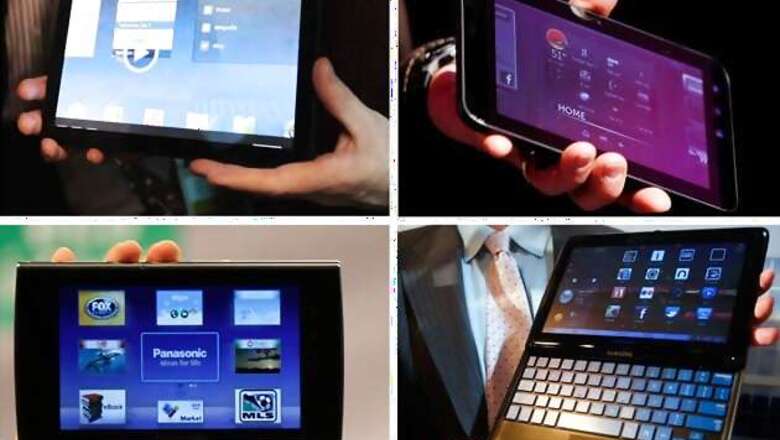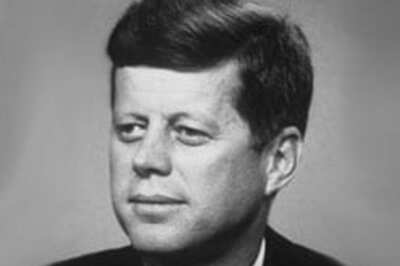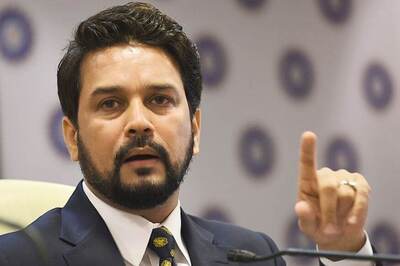
views
New Delhi: If 2010 was the year of dual SIM mobile phones in India, it was the 'tablet PC' that walked away with the title of being the most sought after device in 2011, and technology giants Apple, Samsung and Research in Motion rushed to grab a share of the booming market.
Over the last few years, about a billion mobile phones were being sold annually, but it was the tablets that brought excitement to the world's second largest telecom market this year.
Be it the high-end tablet PCs like iPad, PlayBook and Galaxy Tab or the world's cheapest tablet Aakash, each one created a ripple in the market. And today, there are tablets in various sizes available in the market at different price points.
According to Frost & Sullivan, Indians are estimated to buy three lakh units of tablets in 2011 compared to a sales of about 60,000 tablet PCs in 2010.
The year started with a bang as Apple's iPad finally hit the Indian shores. Though the device was priced higher (between Rs 27,900 and Rs 44,900) than that in markets like the US, it was lapped up by Apple enthusiasts in the country.
Another major launch by Apple was that of the iPhone 4S. Though almost identical to its predecessor in looks, iPhone 4S has an artificial intelligence based assistant called Siri.
The price again played spoilsport as the iPhone 4S carried a hefty tag of Rs 44,500 for the 16GB version. The earlier model is available in India for Rs 34,500 (16GB).
2011 also saw other launches from the Apple stable like cloud service iCloud and operating system iOS 5. However, with the sudden demise of Apple's co-founder Steve Jobs, there have been concerns whether the company would be able to continue introducing winning products.
June witnessed Canadian firm Research in Motion, which offers the BlackBerry service, launching its 'PlayBook' in India at Rs 27,990 (16 GB).
Motorola Mobility India introduced its Android-based tablet PC 'Xoom' in the same month, while Taiwanese handset maker HTC introduced its 'Flyer' in India.
The battle of the tablets continued with Samsung launching its Galaxy Tab 730 (8.9-inch screen) and the much-awaited Galaxy Tab 750 (with 10.1-inch screen) in India, priced at Rs Rs 33,990 and Rs 36,200, respectively.
Even as the race to bring out the next "revolutionary" device continued, Samsung got tangled in legal battles over claims of "slavishly" copying Apple's device design.
As the year progressed, it was raining tablets in the Indian market as telecom operators also joined the bandwagon.
Reliance Communications and Beetel Teletech, a Bharti Enterprises group company, launched their tablet PCs, albeit at a much lower price point to cater to the masses. The Android-based devices were priced at Rs 12,999 (RCom's 3G Tab) and Rs 9,999 (Beetel's Magiq).
Product pricing has always been a crucial growth driver in the cost-sensitive Indian market. In fact, the success mantra for the world's fastest growing telcom market has majorly been low-cost mobile phones by homegrown brands like Micromax, Karbonn and Spice.
Even though popularity of smartphones is rising in India, industry experts are of the view that more than 70 per cent handset sold here are sub Rs 10,000.
With entry of tablet PCs in the sub-Rs 10,000 range, the industry hopes to witness a trend similar to that of handsets. Apart from mobile handset giants and telcom operators, PC manufacturers like Levono, HCL, Asus and Acer were also lured by the fast-growing tablet market here.
Sony, which is known for its sleek Vaio series of laptops, is the latest entrant in the segment with its tablets named S and P.
The year 2011 witnessed some of the most significant and revolutionary developments in the telecom industry, including the launch of 3G services by various operators and mobile subscriber base increasing to 873.61 million in September.
With high speed Internet services like 3G and Long Term Evolution (LTE) on the anvil, sales of tablet PCs and smartphones are set to increase further. The Indian government has set a target of 600 million high-speed Internet connections across the country by 2020.
One of the significant launches in the year was that of Aakash, the world's cheapest tablet device, probably following the success of the world's cheapest car 'Nano'. Developed as part of the government's programme to expand education through information technology, the device is being made available to students at a subsidised price of about Rs 1,200. The government is paying Rs 2,276 per device.
The seven-inch touchscreen tablet flaunts of features such as 256MB RAM, ARM 11 processor with the Android 2.2 operating system, two USB ports and HD-quality video. Although, it may seem that tablets completely overshadowed mobile phones, it was not the case. The handset makers made sure that the billion unit sales continue to grow in the year.
While last year it was all about low-cost dual SIM handsets, 2011 saw companies increasing their smartphone portfolio to cater to the demands of the youth. Smartphones are a major hit amongst the youth, mainly because they enable the younger generation to stay connected 24/7 on social platforms like Facebook.
What also changed during the year was the preference for operating systems (OS). While earlier users would debate about brands, the discussion seemed to move to the OS this year.
The popularity of Google's Android OS powered devices has been on the rise since the launch of HTC Magic the first Android device in the country. According to the research firm IDC, Android surpassed Symbian OS to emerge as the top platform in India for the first time. Not to be left behind, Nokia decided to gradually move away from Symbian and struck one of the largest alliances in the history of gadgets with Microsoft.
Announced in February, the partnership saw Nokia adopting Microsoft's Windows Phone OS as its main smartphone platform. Since then, Nokia has launched -- Lumia 800 and Lumia 710 - to remain ahead in the smartphone race.
While the Nokia-Microsoft pact materialised, Sony and Ericsson decided to part ways in October after a decade. The transaction is expected to close in January next year.
The year, however, did not bring much cheer for Research In Motion (RIM). Though RIM's BlackBerry devices continued to gain traction in India, globally its market share declined. Further, in October, scores of BlackBerry users faced problems in accessing the e-mail, messenger and other online services on their smartphones for three days due to a core switch failure.
Another major event in the devices segment was the acquisition of Motorola Mobility by Internet search giant Google for USD 12.5 billion, making it the biggest ever takeover by the Internet giant so far.
For Samsung, 2011 was fairly good. Although still number two in the Indian handset market, experts are of opinion that the smartphones like the Galaxy SII and Note will give a major push to its growing influence.
Year 2012 promises to be just as eventful, both from the perspective of tablets and mobile phones.
While the tablet PC market is geared up for intense competition as vendors like Micromax, G'Five and Karbonn launch their devices in the market, established players would also bring out newer models to compete in the intense battle.
On the handset front, one will wait for the launch of iPhone 5 as well as the new Android 4.0 operating system - codenamed Ice Cream Sandwich -- to hit the Indian markets.
Nokia's Belle - the next version of Nokia's Symbian operating system is also expected to come in along with the new budget series.




















Comments
0 comment